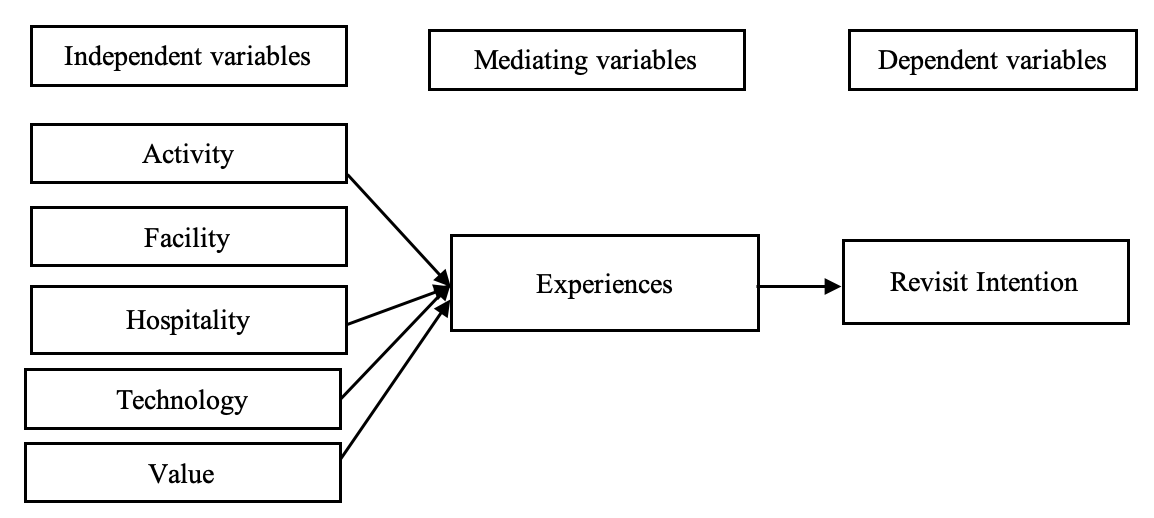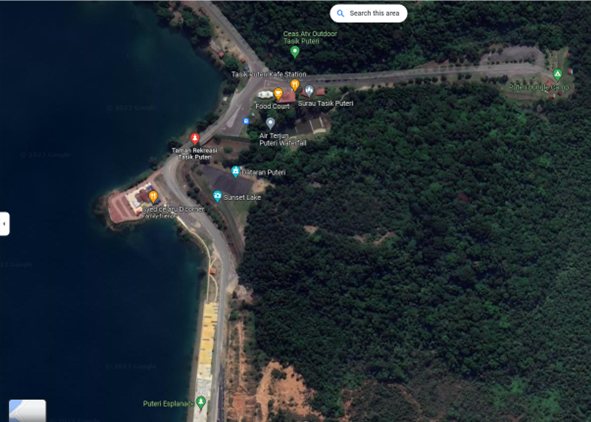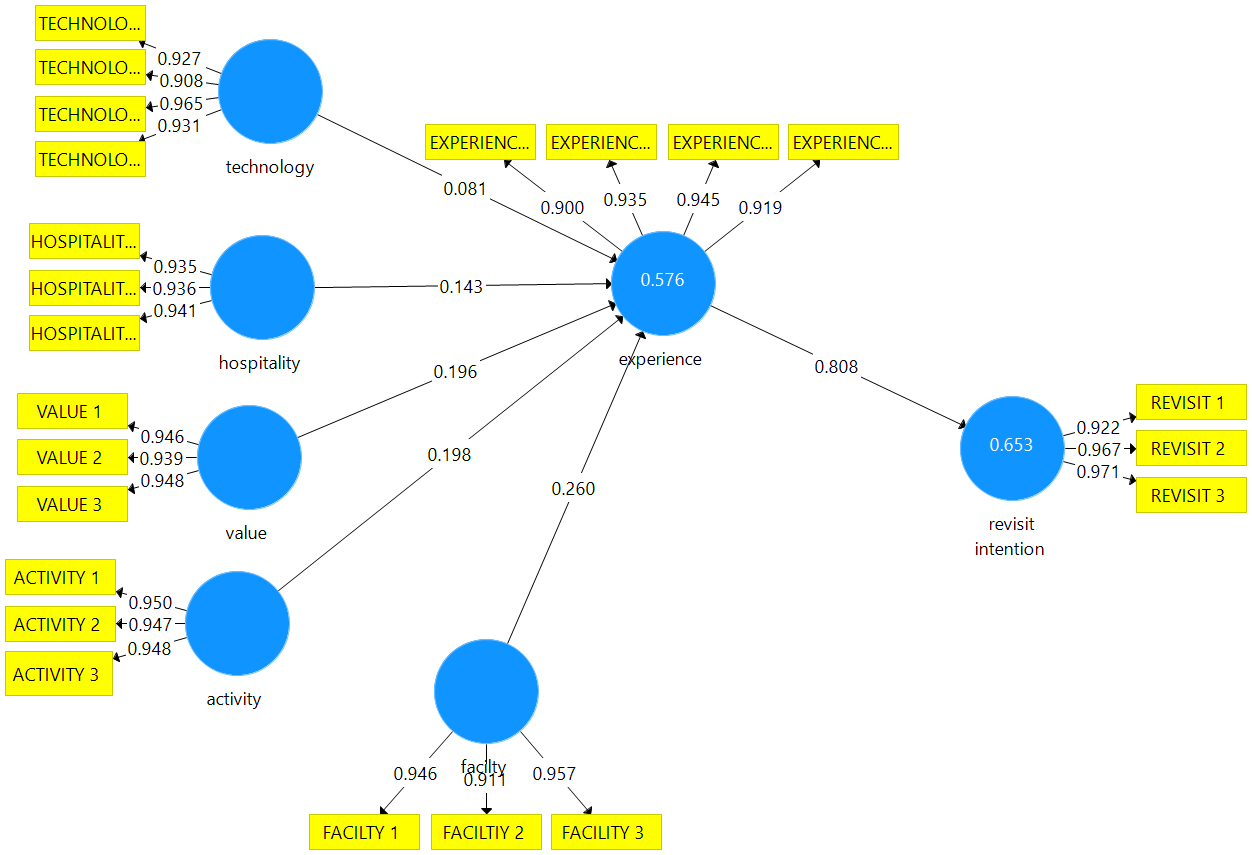Abstract
This study aimed to examine the determinants affecting visitor revisit intention at Malaysian ecotourism locations between January and March 2022. Five determinants of destination attributes that consists of activities, facilities, hospitality, technology and values are examined towards memorable experience and visitor revisit intention to Tasik Puteri, Dungun Terengganu. A causal study used focusing at quantitative methods. The respondents are 202 respondents, those who have visited Tasik Puteri in Dungun, Terengganu. The assessment and measurement data were analysed and interpreted using the SEM PLS. The findings highlight that activities, facilities, and values affected visitors' memorable experiences and mediate the effects of revisit intention. Meanwhile, the hospitality and technology variables is not giving impacts to the visitor experience and revisit intention. The destination management company (DMC) will use the study's findings to improve and strategically plan this and future ecotourism sites' short- and long-term development. The findings also highlighted that activity, facilities, and perceived values are important for the destination.
Keywords: Destination, Ecotourism, Memorable Experience, Revisit Intention
Introduction
Ecotourism destination is among the popular tourism products in Malaysia. In the Year 2019, before the pandemic covid-19, the industry was able to attract 26.10 million tourist arrival to Malaysia (MOTAC). National Ecotourism plan (2016 - 2025) reveal five distinguished features of ecotourism, namely a) Conservation of nature and culture, b) Reinvestment of income to maintain quality of resource and conservation, c) Ecologically, economically and sociocultural sustainability, d) Ethical, demonstrating corporate social responsibility and e) Education about biodiversity, habitats, and cultures. The importance of ecotourism in Malaysia has been highlighted in the National ecotourism plan (1996) and reviewed in 2016. It highlights the essential components required for ecotourism destinations in Malaysia and shows the unique criteria of ecotourism attributes in Malaysia.
The ecotourism destination is a unique attraction in Malaysia, and it is required to be competitive. Understanding visitor travel patterns is required to ensure the destination's sustainability and competitiveness. Several studies have claimed that travel patterns determining tourist destinations are influenced by many factors, such as decision-making, age, gender, marital status, perceived value (Wachyuni & Kusumaningrum, 2020), memorable tourism experience (Mahdzar et al., 2015; Monika et al., 2021; Zhang et al., 2018) destination attributes (Mahdzar et al., 2015) and Smart Tourism Technology (Pai et al., 2021). Intention to revisit and satisfaction are also interrelated to the travellers’ experiences in tourism activities (Ramires et al., 2018). They highlighted various factors that influence visitors to travel to specific destinations.
Tasik Puteri, Bukit Besi, Malaysia, located on the East Coast of Peninsular Malaysia, is among the must-visit destinations at Terengganu and is famous for its ecotourism attraction. It has been featured in newspapers and social media platforms as a place with a beautiful lake, beautiful scenery, and natural attractions such as waterfalls and as a site for sport tourism activities (KETENGAH) Based on existing literature on Tasik Puteri and Bukit Besi, studies have predominantly emphasised science and technology areas, such as the previous iron ore mining’s impact on the water quality of Tasik Puteri (Khalid et al., 2018) and water treatment of the lake (Draman et al., 2020; Mohd Sidek et al., 2018). There are limited studies focusing on Tasik Puteri as a beautiful tourist attraction at Bukit Besi, Terengganu, on the lake's heritage or history. Previously an IPA analysis was conducted at this place and the result showed that the findings highlight the Tasik Puteri in Dungun Terengganu ecotourism areas' destination quality and it showed several areas that need improvement for this destination (Hamid et al., 2022). Hence this showed the necessity to examine the travel pattern among the visitors that visit this destination.
This study examines the factors that influence the visitors to visit Tasik Puteri at Dungun Terengganu. The objectives of this study are to examine the influences of a) activity, b) facility, c) hospitality, d) technology, and e) value towards the experience and the experience mediating the factors to revisit intention. Figure 1 highlights the framework used in this study.

Research Methodology
Study site
Tasik Puteri, formerly known as Tasik Bukit Besi, is a historical iron ore mine that has been abandoned. It was one of South East Asia's largest iron ore mines. It is a "man-made" lake created when the Besut River was converted into a reserve. In addition to the lake, this location offers various amenities and activities that draw both locals and tourists to enjoy the area.

Study design
The study's sample population comprises locals and domestic tourists in Terengganu and Malaysia. In 2021, there were about 1.28 million local people in Terengganu, while there will be 7.4 million domestic tourists visiting the region from all of Malaysia (DOSM, 2022). Based on figure 2, there are 202 total samples available, and convenience sampling is the sampling method used. The data was gathered in person at Tasik Puteri Dungun and online, over three months, between January and March 2022. The measurement and structural model were assessed using the SmartPLS 3.3.9 software.
Data Analysis and Discussion
Profile of respondent
Table 1 highlights the respondents' demographic profile. The findings revealed that 61.9 percent of respondents were female and 38.1 percent were male. Meanwhile, 9.4% of respondents were under 20 years old, 44.1% were in the 20–30 age range, 24.3 percent of respondents were between the ages of 31 and 40, while the remaining 22% were, respectively, between the ages of 41 and 50 (17.8 percent) and 51 and older (4.4 percent). As for origin, 58.9 percent of the respondents were not from Terengganu, with 41.1 percent being from Terengganu. The results for the frequency of visits showed that 56.4 percent had made three visits, 34.2 percent had made one visit, and the remaining 9.4 percent had made two visits. The majority of respondents (55.2%) visited the site for vacation-related reasons, followed by 22.6%) for business objectives and (11.3%) each for visiting friends or family members in the final demographic category, "reason for visit." 7.78 percent of those who responded still visited the site for other reasons.
Testing the measurement model
The analysis commenced by using convergent and discriminant validity analyses to assess the reflective measures. Factor loadings, composite reliability, and average variance extracted (AVE) were performed to examine convergence validity. The loadings for all reflective items exceeded the recommended value of 0.7, which ranged between 0.900 and 0.971. Composite reliability (CR) values that showed the degree to which the items indicated the latent construct ranged between 0.956 and 0.968 and exceeded the recommended value of 0.7. The average variance extracted ranged between 0.856 and 0.909, which exceeded the recommended value of 0.5. Discriminant validity was determined by comparing the average variance extracted from each construct with communal variances shared with other constructs. Table 2 presents the outer loadings, AVE, and CR.
Testing the structural model
Table 3 recapitulates the structural model generated by PLS analysis. This table charts the standardized path coefficients (β) and p-values observed with the level of significance that had been achieved. As tabulated in figure 3, the model displays the result of the relationship between variables.
Firstly, six direct effects were tested. The results showed that activity does influence experience (β=0.198, p=0.038). Additionally, experience does influence revisit intention (β=0.808, p=0.000). Next, facility significantly influenced experience (β=0.260, p=0.018), whereas hospitality had no significant influence on experience (β=0.143, p=0.087). Technology displayed no significant influence on experience (β=0.081, p=0.131), while value significantly influenced experience (β=0.196, p=0.047).
As for the specific indirect effects, according to table 3, there is no significant effect between technology, experience, and revisit intention (β=0.066, p=0.0132). The same goes with hospitality, experience, and revisit intention (β=0.116, p=0.088), whereby the results showed no significant relationship between these exogenous and endogenous variables. However, for value, experience, and revisit intention, the results presented significant influence among these three (β=0.159, p=0.0049) variables. Furthermore, from the results obtained, facility, experience, and revisit intention exhibited significant influence (β=0.210, p=0.020) among each other. Lastly, activity, experience, and revisit intention showed significant influence as well (β=0.160, p=0.039).

Discussion
The study outcomes indicated that activity had a significant effect on experience. (Su et al., 2021) support these findings in their study, highlighting that challenging tourism activities have a stronger positive effect on travel experience sharing than relaxing tourism activities. Furthermore, this current study showed a significant relationship between experience and revisit intention. Satisfaction is related to the degree of positive feeling the experience creates (Chen & Chen, 2010). Preceding research (Chen & Rahman, 2018; Kim, 2018) approves the relationship between memorable tourism experience, satisfaction, and revisit intention in destination-marketing. Also confirming the previous studies’ results, the study by (Cifci, 2022) supports that memorable experience positively links to overall satisfaction and revisiting intention.
The study's outcomes revealed a positive effect on the relationship between facility and experience. Furthermore, this study also proved that there is no relationship between hospitality and experience, as well as no relationship between technology and experience. However, this study showed a significant relationship between value and experience, supported by (Shen, 2016) claimed that perceived value had been found to have a direct positive impact on behavioural intention. Nevertheless, the tourism experience may also influence this impact since it is the outcome of the values tourists perceive. It has been acknowledged as an influential driver of future behavioural intention Kim (Kim, 2018).
According to table 3, this study discovered no indication of the indirect effect between technology, experience, and revisit intention. This study also proved no significant relationship between hospitality, experience, and revisit intention. However, it supports the relationship between values towards experience and revisit intention and between facilities towards experience and revisit intention. (Chen & Chen, 2010) considered the relationship between the educational experience and travellers satisfaction via 477 heritage tourists in Taiwan. The outcome discovered that the educational experience helps increase perceived value, leading to a high level of satisfaction for travellers (Mahdzar et al., 2015). Moreover, a study conducted by (Wang et al., 2010) discovered the behaviour of tourists revisiting harbour attractions in Taiwan, which demonstrated that tourists who were more satisfied with their travel experience were keener to revisit the same destination in the future. Lastly, this study showed a significant relationship between activity, experience, and revisit intention. According to (Barnes et al., 2016), visitors experiencing positive affect are the most expected to exhibit positive post-consumption behaviours in a tourism setting (Hosany & Prayag, 2013). This indicate the importance of activity, and positive experience affecting the revisit intention.
Conclusion
The study examines the factors that affect the visitor revisit intention to ecotourism destination in Terengganu. Five variables are tested towards the memorable experience, and the indirect effects are tested to revisit intention. The result reveals that visitors' perceived values, activities, and facilities are the important attributes that affected the experience and their revisit intention. However, the visitor perceived hospitality and technology at this destination are still insignificant to their behaviours. This study proves that the ecotourism destination must provide suitable activities and facilities. The destination should give value to the visitors to entice them to have a good experience and influence their revisit intention.
Future studies should highlight the impacts of hospitality and technology at this destination, which is also an essential component of the ecotourism destination. The Destination Management Company (DMC) should plan to use the technology and increase the hospitality services at this destination. Both components are proven to affect visitor satisfaction; however, they still need to be fulfilled at this destination.
Acknowledgments
This study is funded under Research Collaboration fund (RCF 2020-SS( 9/2021). Thank you to UiTM Terengganu and KETENGAH for supporting this study.
References
Barnes, S. J., Mattsson, J., & Sørensen, F. (2016). Remembered experiences and revisit intentions: A longitudinal study of safari park visitors. Tourism Management, 57, 286-294. DOI: 10.1016/j.tourman.2016.06.014
Chen, C.-F., & Chen, F.-S. (2010). Experience quality, perceived value, satisfaction and behavioral intentions for heritage tourists. Tourism Management, 31(1), 29-35. DOI:
Chen, H., & Rahman, I. (2018). Cultural tourism: An analysis of engagement, cultural contact, memorable tourism experience and destination loyalty. Tourism Management Perspectives, 26, 153-163. DOI:
Cifci, I. (2022). Testing self-congruity theory in Bektashi faith destinations: The roles of memorable tourism experience and destination attachment. Journal of Vacation Marketing, 28(1), 3-19. DOI:
DOSM. (2022). DOSM. Department of Statistics Malaysia. https://www.dosm.gov.my
Draman, S. F. S., Khalid, S. A., Sidek, N. M., Abdullah, S. R. S., & Anuar, N. (2020). Phytotoxicity Study of Native Plants in ex-mining lake water treatment. IOP Conference Series: Materials Science and Engineering, 808(1), 012040. DOI:
Hamid, M. A., Fuza, Z. I. M., Mahmood, R., Ahmad, Z., & Sinaga, E. K. (2022). Importance - performance analysis of destination quality for ecotourism site in Tasik Puteri, Terengganu, Peninsular Malaysia. IOP Conference Series: Earth and Environmental Science, 1102(1), 012075. DOI:
Hosany, S., & Prayag, G. (2013). Patterns of tourists' emotional responses, satisfaction, and intention to recommend. Journal of Business Research, 66(6), 730-737. DOI:
Khalid, S. A., Draman, S. F. S., Abdullah, S. R. S., & Anuar, N. (2018). Assessment Of Iron Ore Ex-Mining Lake – Seasonal Influence on Water Quality of Tasik Puteri, Bukit Besi. Malaysia. International Journal of Engineering & Technology, 7(September 2020), 84–88. DOI:
Kim, J.-H. (2018). The Impact of Memorable Tourism Experiences on Loyalty Behaviors: The Mediating Effects of Destination Image and Satisfaction. Journal of Travel Research, 57(7), 856-870. DOI:
Mahdzar, M., Shuib, A., Ramachandran, S., & Herman Mohammad Afandi, S. (2015). The Role of Destination Attributes and Memorable Tourism Experience in Understanding Tourist Revisit Intentions. Tourism & Environment, Social and Management Sciences, 15, 32–39. DOI:
Mohd Sidek, N., Sheikh Abdullah, S. R., Ahmad, N. U., Syed Draman, S. F., Mohd Rosli, M. M., & Sanusi, M. F. (2018). Phytoremediation Of Abandoned Mining Lake by Water Hyacinth and Water Lettuces in Constructed Wetlands. Jurnal Teknologi, 80(5). DOI: 10.11113/jt.v80.10992.
Monika, B., Thamaraiselvan, D., & Sivanesan, D. (2021). Examining Memorable Tourism Experience On Memorable Trip Experience, Subjective Well-Being And Revisit Intention. Journal of Contemporary Issues in Business and Government.
Pai, C., Kang, S., Liu, Y., & Zheng, Y. (2021). An Examination of Revisit Intention Based on Perceived Smart Tourism Technology Experience. Sustainability, 13(2), 1007. DOI:
Ramires, A., Brandão, F., & Sousa, A. C. (2018). Motivation-based cluster analysis of international tourists visiting a World Heritage City: The case of Porto, Portugal. Journal of Destination Marketing & Management, 8, 49-60. DOI:
Shen, Y. (2016). ScholarWorks@UMass Amherst Perceived Value in Tourism Experience Perceived Value in Tourism Experience. http://scholarworks.umass.edu/ttra/2016/Grad_Student_Workshop/8
Su, L., Tang, B., & Nawijn, J. (2021). How tourism activity shapes travel experience sharing: Tourist well-being and social context. Annals of Tourism Research, 91, 103316. DOI:
Wachyuni, S. S., & Kusumaningrum, D. A. (2020). The Effect of COVID-19 Pandemic: How are the Future Tourist Behavior? Journal of Education, Society and Behavioural Science, 67-76. DOI: 10.9734/jesbs/2020/v33i430219
Wang, Y.-J., Wu, C. K., & Yuan, J. J. (2010). Exploring Visitors' Experiences and Intention to Revisit a Heritage Destination: The Case for Lukang, Taiwan. Journal of Quality Assurance in Hospitality & Tourism, 11(3), 162-178. DOI:
Zhang, H., Wu, Y., & Buhalis, D. (2018). A model of perceived image, memorable tourism experiences and revisit intention. Journal of Destination Marketing & Management, 8, 326-336. DOI:
Copyright information

This work is licensed under a Creative Commons Attribution-NonCommercial-NoDerivatives 4.0 International License.
About this article
Publication Date
29 November 2023
Article Doi
eBook ISBN
978-1-80296-131-7
Publisher
European Publisher
Volume
132
Print ISBN (optional)
-
Edition Number
1st Edition
Pages
1-816
Subjects
Accounting and finance, business and management, communication, law and governance
Cite this article as:
Hamid, M. A., Fuza, Z. I. M., Mahmood, R., Ahmad, Z., & Gaffar, V. (2023). Determinants Affecting the Visitor Revisit Intention at Ecotourism Destination. In N. M. Suki, A. R. Mazlan, R. Azmi, N. A. Abdul Rahman, Z. Adnan, N. Hanafi, & R. Truell (Eds.), Strengthening Governance, Enhancing Integrity and Navigating Communication for Future Resilient Growth, vol 132. European Proceedings of Social and Behavioural Sciences (pp. 486-495). European Publisher. https://doi.org/10.15405/epsbs.2023.11.02.37

